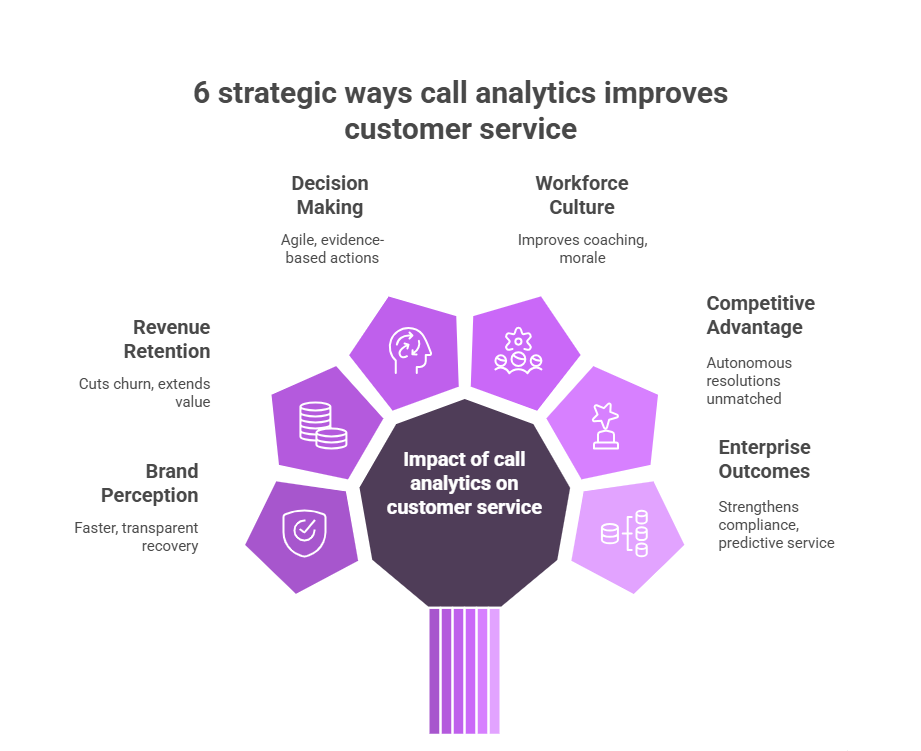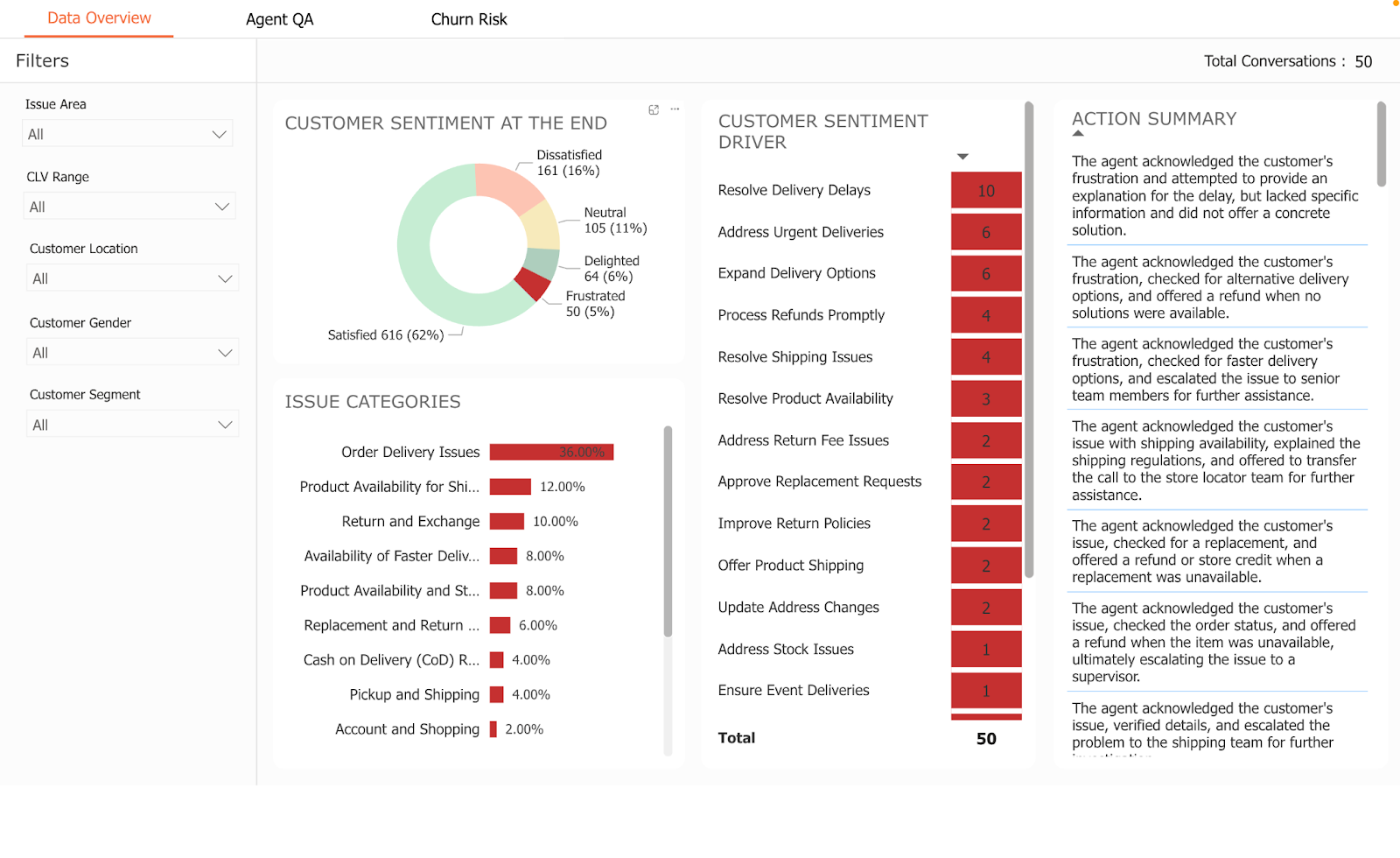In this guide
What is the impact of call analytics on customer service?

The impact of call analytics on customer service in 2025 is measurable: it builds customer trust, reduces churn, accelerates decision-making, improves workforce performance, fuels product innovation, and secures long-term competitive advantage.
TL;DR: The impact of call analytics on customer service in 2025
Call analytics transforms customer service by delivering measurable improvements across six areas:
- Trust & brand perception – Detects frustration in real time, enabling faster, more transparent recovery.
- Revenue & retention – Cuts churn, extends customer lifetime value, and reveals upsell opportunities.
- Decision-making – Replaces lagging survey data with live insights, enabling agile, evidence-based actions.
- Workforce & culture – Makes QA fair and data-driven, improving coaching, morale, and retention.
- Competitive advantage – Differentiates service with full coverage and autonomous resolutions competitors cannot match.
- Enterprise outcomes – Strengthens compliance, enables predictive service, and positions contact centers as intelligence hubs.
Top 6 benefits of call analytics in customer service

Here are six measurable impacts of call analytics on customer service that every leader should track.
1. Customer trust and brand perception in customer service
Call analytics strengthens trust by turning service pressure moments into proof of reliability. Real-time visibility into early warning signals helps teams act before dissatisfaction escalates.
- Real-time transparency: When problems arise, customers expect fast, honest responses. Call analytics detects frustration instantly, reducing repeated explanations and reinforcing brand credibility.

- Emotion-aware engagement: AI sentiment analysis highlights when conversations are emotionally charged. Agents can respond with empathy, preventing escalation. Zendesk (2025) reports nearly half of customers believe AI agents can be empathetic, underscoring the role of emotional intelligence in modern service.
2. Revenue growth and customer retention in customer service
Call analytics ties customer service directly to measurable financial outcomes such as churn reduction, lifetime value, and upsell revenue.
- Churn reduction and lifetime value gains: By detecting dissatisfaction signals early, leaders can deploy targeted interventions. Each saved customer increases lifetime value and protects recurring revenue streams. Forrester found that customer-obsessed organizations achieve 51% better retention than peers, showing the business case for analytics-driven service.

- Upsell and cross-sell potential: Customer conversations often reveal upgrade needs or interest in add-ons. Call analytics identifies these buying signals and routes them to sales teams, turning support calls into growth opportunities instead of cost burdens.
3. Faster decision-making in customer service
Slow reaction cycles remain one of the biggest risks for service leaders. Surveys and quarterly reviews provide lagging indicators that arrive too late to prevent churn or compliance failures.
Call analytics eliminates this gap by transforming every call into live intelligence on sentiment, intent, and churn risk.
With these unbiased call drivers, leaders can adjust staffing, scripts, or escalation paths within days instead of quarters, reducing exposure to systemic issues. In volatile markets, this agility decides whether service teams stay ahead of customer expectations or fall behind competitors.
4. Workforce performance and service culture in customer service
AI-driven call analytics makes workforce evaluation objective and transparent. It removes bias from assessments, ensuring agents are judged on consistent standards.
- Fair and targeted coaching: Agent QA with customizable AI rules surface coaching opportunities, enforce quality, and provide fair recognition. This increases engagement and lowers attrition.
- Agents as insight generators: Instead of being limited to issue resolution, agents contribute to enterprise knowledge. For leaders, this means a motivated workforce that fuels both service quality and organizational growth.

5. Competitive advantage in 2025 customer service
When product and price converge, customer service quality becomes the deciding factor in customer loyalty and renewals. Call analytics gives executives full coverage of every interaction, providing intelligence that competitors relying on sampled QA or surveys cannot match.
Early adopters of agentic AI are advancing toward autonomous resolutions for routine issues. This reduces escalations, improves first-contact resolution, and frees frontline teams to focus on higher-value work. Embedding customer voice at scale creates a defensible advantage that traditional service models cannot match.
6. Long-term enterprise outcomes of call analytics in customer service
The long-term benefits of call analytics extend beyond customer service. Contact centers evolve into intelligence hubs that influence compliance, product strategy, and financial planning.
- Compliance and governance: AI-powered monitoring flags regulatory risks, ensures disclosure accuracy, and creates audit-ready transcripts, strengthening governance and trust.
- Predictive service: As call analytics matures, predictive models resolve issues before customers even reach support. This reduces costs, strengthens resilience, and positions service as a driver of shareholder value.
Conclusion
The impact of call analytics on customer service in 2025 is transformative. It strengthens trust, reduces churn, accelerates decisions, improves workforce culture, fuels product innovation, and creates enterprise-wide value.
For leaders, the call is clear: treat service conversations as data assets, integrate insights into training, playbooks, and product cycles, and hold teams accountable for measurable improvements in CSAT, FCR, and retention.
👉 Want to turn conversations into growth levers? Start your free trial with Clootrack and experience how AI-powered call analytics transforms customer service into a strategic advantage.
FAQs
Q1: How does predictive call analytics reduce customer effort?
Predictive call analytics reduces customer effort by resolving issues before customers need to reach support. This proactive approach cuts repeat contacts and improves first-contact resolution.
Q2: What role does call analytics play in improving agent performance?
Call analytics improves agent performance by providing full visibility into tone, sentiment, and communication patterns. Leaders can identify strengths, close compliance gaps, and design targeted coaching programs.
Q3: How does call analytics integrate with omnichannel service?
Call analytics integrates with chat, email, and digital channels to create a single view of sentiment and intent. This ensures seamless handoffs and consistent service across touchpoints.
Q4: Can call analytics reduce operational costs in contact centers?
Yes, call analytics reduces operational costs by automating QA and lowering inefficiencies. It shortens handle times, reduces repeat calls, and improves staffing accuracy.
Q5: What compliance and risk benefits does call analytics provide?
Call analytics strengthens compliance by monitoring disclosures, flagging risks, and producing audit-ready transcripts. This helps leaders reduce violations and protect customer trust.
Do you know what your customers really want?
Analyze customer reviews and automate market research with the fastest AI-powered customer intelligence tool.




